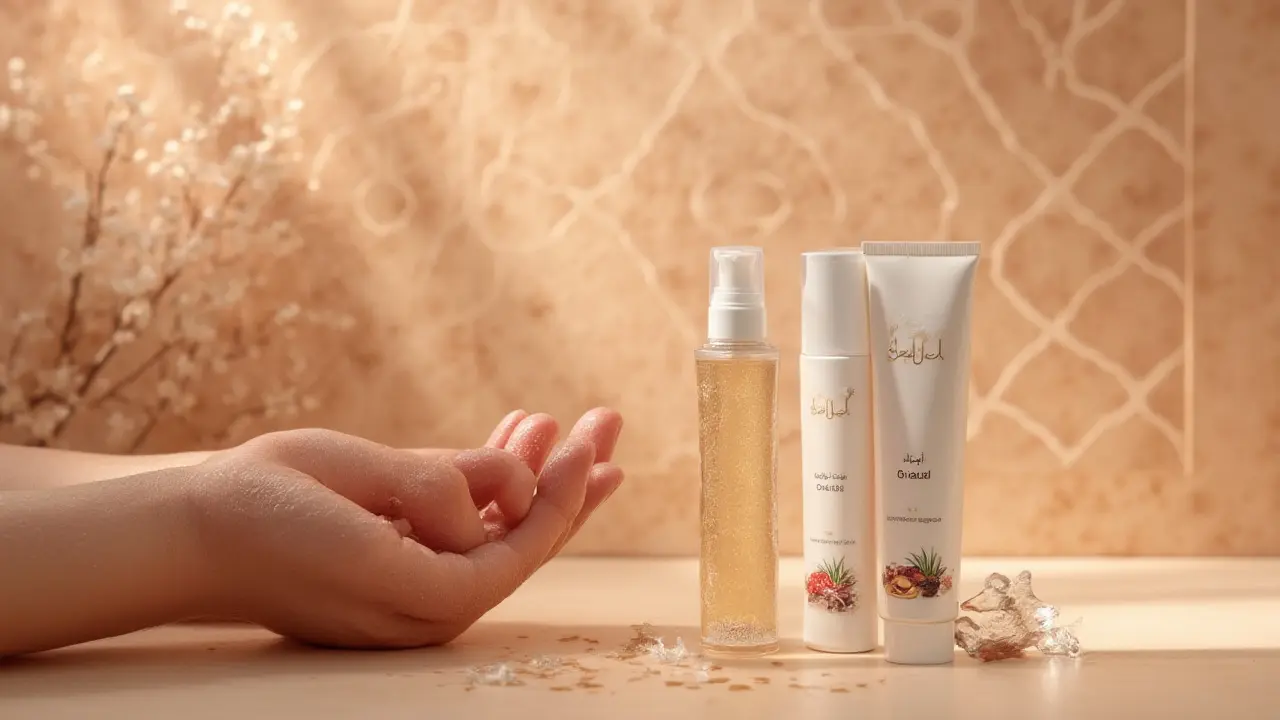You know the feeling: you’re standing in the shower, gritty scrub in hand, dreaming of silky skin. But is that scrub really doing your skin any favors—especially according to dermatologists? Turns out, expert opinions get pretty interesting when you dig into the science behind exfoliation.
Are Body Scrubs Really Dermatologist-Approved?
If you think all dermatologists give the green light to body scrubs, hold up a second. Most skin experts agree, exfoliation can help slough off dead skin cells and make your skin smoother. But the debate gets loud about how often and what to use—gentle scrubs or harsh ones? Physical or chemical exfoliants? There’s no universal answer. Still, several dermatology associations, including the American Academy of Dermatology (AAD), support gentle exfoliation for most people, as long as you don’t overdo it or pick the wrong scrub.
Some dermatologists love scrubs, especially the mild kind. They often suggest sugar or oatmeal-based formulas, which melt away easily and are less abrasive. Skin specialists see less value in harsh walnut shell scrubs or those with big, uneven particles. These can scratch the skin and cause microtears, basically inviting irritation and breakouts—exactly what you were hoping to avoid.
On the other hand, if you have highly sensitive skin, eczema, or conditions like psoriasis, a scrub might not do you any favors. Dermatologists tend to lean toward chemical exfoliants like lactic acid or glycolic acid for these cases, or they recommend skipping scrubs completely and focusing on moisturizing instead. So if you’ve got tricky skin, it’s smart to chat with your dermatologist before reaching for any kind of exfoliator. My daughter Leora once tried an apricot scrub on her arms—instant redness, followed by a lecture from our family doctor.
Here's something many don’t realize: even though spa menus love to use words like “detoxifying scrub” or “deep cleansing polish,” dermatologists don’t buy into those promises. The skin naturally gets rid of dead cells, and scrubs are just a way to speed up or assist the process a bit. They aren’t magic cures, but they do offer that satisfying, smooth feeling when used correctly.
Let’s look at an example table showing dermatologist recommendations and common exfoliant types for different skin concerns:
| Skin Type/Concern | Dermatologist Preference | Suggested Scrub Type |
|---|---|---|
| Normal Skin | Gentle physical or chemical exfoliant, 1-2x per week | Sugar, oatmeal, fine jojoba beads |
| Sensitive Skin | Chemical exfoliant or avoid scrubs | Lactic acid (low concentration), no rough scrub |
| Dry Skin | Gentle scrub, avoid over-scrubbing, follow with moisturizer | Sugar or salt (dissolves quickly) |
| Oily/Acne-prone | Chemical exfoliant usually preferred | Salicylic acid, glycolic acid, avoid harsh particles |
| Psoriasis/Eczema | Usually avoid scrubs; focus on hydration | N/A |
So, when someone asks if dermatologists recommend a body scrub, there’s more nuance than a simple yes or no. It’s really about your unique skin type, your habits, and what’s actually in your scrub jar.
How to Use Body Scrub Safely: Best Practices and Common Mistakes
Ever notice your skin stings or gets itchy after a scrub-down? That’s a red flag, and trust me, I’ve ignored it too many times (sorry, Tristan—you inherited your dad’s stubborn genes). Even with dermatologist-approved scrubs, how you use them matters. Let’s break down how to get that glow without the ouch.
Rule number one: less is more. Most experts suggest exfoliating just once or twice a week—any more, and you could end up tearing your skin barrier. The shower is the perfect place for scrubbing because your skin’s already soft and hydrated, making it easier to buff away those dead cells. Always use circular, gentle motions instead of scrubbing like you’re trying to clean the family barbecue grill. And if you see redness or scratches, dial it back.
Got a favorite DIY body scrub pinned on Pinterest? Go for it, but watch what goes into the mix. Skip anything with jagged particles like ground coffee or fruit pits for your body, and never use them on your face. My son Tristan once whipped up a salt scrub for his elbow, but he learned the hard way that kitchen salt and delicate skin don’t always mix. If you want a pro tip, look for scrubs that contain nourishing oils—think coconut, shea, or sweet almond—that help counteract any dryness and leave your skin feeling soft, never tight.
Speaking of dryness, this is where people mess up the most. If your skin feels squeaky after using a scrub, you’ve likely stripped away too much natural oil. Always follow up with a rich moisturizer, like a body balm or even a classic thick lotion. You’ll lock in hydration and keep that baby-soft feeling much longer.
Steer clear of scrubs on broken, sunburned, or freshly shaved skin. That’s asking for major irritation. And remember, not every area of your body needs the same level of scrubbing—elbows, knees and feet, sure; delicate chest or neck, use a lighter touch or skip altogether.
A few key tips dermatologists share for safe scrubbing:
- Start with a patch test if you’re trying a new product or DIY recipe.
- Choose fine-grit scrubs and avoid large, sharp granules.
- Don’t mix physical and chemical exfoliants at the same time. Alternate if you want benefits from both.
- Moisturize immediately after exfoliating to soothe and protect.
- If you use retinoids or strong actives for acne, skip scrubs—your skin’s probably already sensitive.
How about after a spa visit? Professional body scrubs (the kind you get at a hammam or luxury spa) usually use gentle but effective products and trained hands, which can feel a lot different than what you do at home. Still, it’s a good idea to speak up about your skin type before treatment so your therapist can adjust the technique or swap in a gentler formula.
If you love data like I do, a 2022 study in the Journal of Cosmetic Dermatology found people who exfoliated weekly with a sugar scrub reported higher satisfaction with skin smoothness (about 78%) versus those who didn’t exfoliate at all (42%). But, they also saw an uptick in mild redness as a side effect, showing that monitoring your skin's response is key. Basically, tune in to what your body tells you.

Picking the Right Scrub: Ingredients, Personalization, and When to Skip It
Walk into any beauty aisle or spa in Dubai, and it’s easy to get dizzy just looking at all the options. Salt, sugar, charcoal, coffee, fruit extracts…there’s a scrub for every vibe. But do dermatologists have favorites? Turns out, yes—and what’s good for one person might not be a match for another.
If you’ve got drier skin or live in a dry climate (like Dubai most of the year), sugar scrubs get high marks. They dissolve quickly and don’t scratch up the skin. Salt scrubs, while great for rougher zones like heels or elbows, can sting if you have nicks or are freshly shaved. Oatmeal-based scrubs stand out for people with sensitive or redness-prone skin, since oatmeal calms and moisturizes at the same time.
What about the “natural = better” trend? Dermatologists warn that just because an ingredient is natural or organic doesn’t mean it’s safe or works for everyone. For example, citrus oils can sometimes worsen sun sensitivity, and essential oils, though trendy, can trigger reactions. Watch for products with added fragrance, artificial colors, or preservatives—these can set off rashes for certain people.
If you’re devoted to spas, check if your favorite uses scrubs with shea butter, coconut oil, or glycerin. These not only exfoliate but hydrate too, which is a double win. Don’t stress over “activated charcoal” or “detox” claims; there’s little evidence these add much value, according to dermatologist-published reviews. But if you like the feel, go for it—as long as it's gentle.
Planning a home routine? Grab a container of fine brown sugar and mix it with honey and oil for a basic but effective scrub. Stay away from large Epsom salt grains or leftover morning coffee grounds unless you want your drain—and your skin—to suffer. If you have body acne, look for chemical exfoliants like salicylic acid in your scrub, which can help keep pores clean without abrasion.
And there are definitely times when you should completely skip body scrubs. If you’ve gotten a sunburn (Tristan learned that on a vacation—ouch), if your skin’s irritated or flaring up, or if you’re using strong medications like retinoids or acne prescriptions, give your skin a break. The skin will heal better if you avoid friction and focus on barrier repair and gentle moisture instead.
Kids and teens? Dermatologists rarely suggest any type of scrub for little kids or sensitive teen skin. I tell Leora to stick with a simple wash and rich lotion, and she’s pretty happy with it.
So, what’s the bottom line? Scrubs can be part of a fun skin ritual—either at home or in the spa—if you pick the right type and respect your skin’s limits. It’s not about scrubbing every day, but about understanding body scrub benefits and using them strategically. Your skin, and your mirror, will thank you.
FAQ
- Do dermatologists think body scrubs are good for you?
Many say gentle body scrubs are fine for most skin types, but they don’t recommend harsh, frequent scrubbing. Gentle is the key word. - How often should you use a body scrub?
Once or twice a week is enough for most people. More often can lead to irritation and dryness. - Can body scrubs help with body acne?
Some scrubs with salicylic acid can help, but physical scrubs might make acne worse. Try chemical exfoliants if you have breakouts. - What ingredients should you avoid in scrubs?
Skip sharp, rough particles like walnut shells or apricot pits. Avoid scrubs with lots of added fragrance or essential oils if you have sensitive skin. - Should sensitive skin types use scrubs at all?
It’s best to consult your dermatologist. Often, chemical exfoliants or just moisturizers are better options for sensitive skin.


